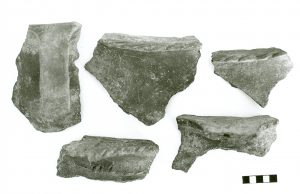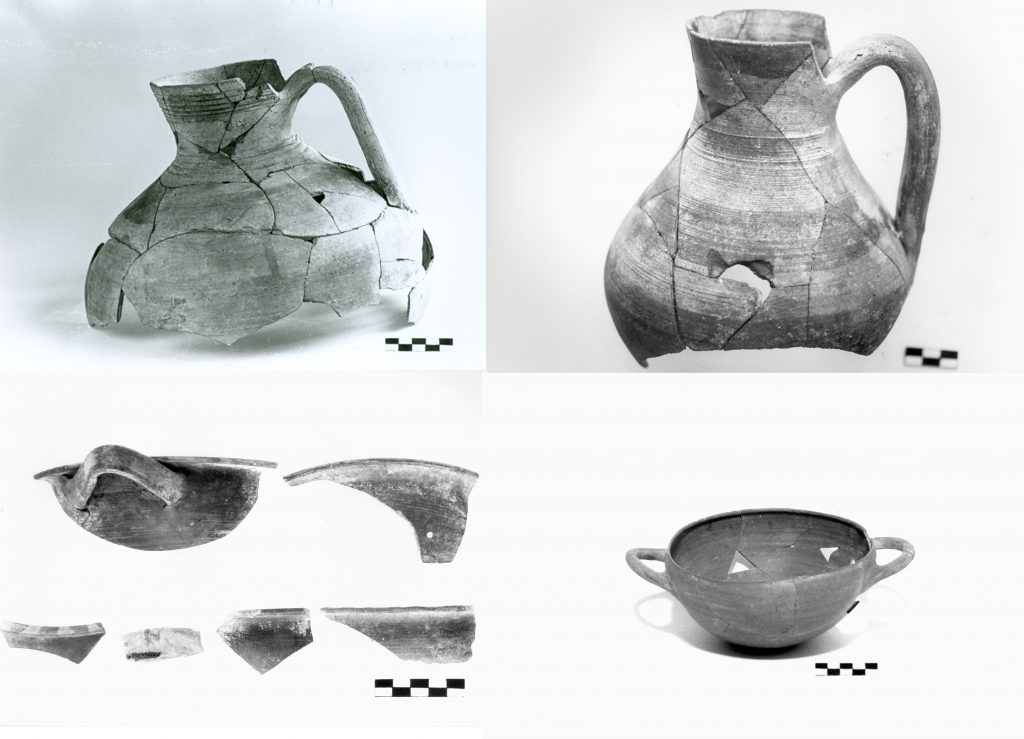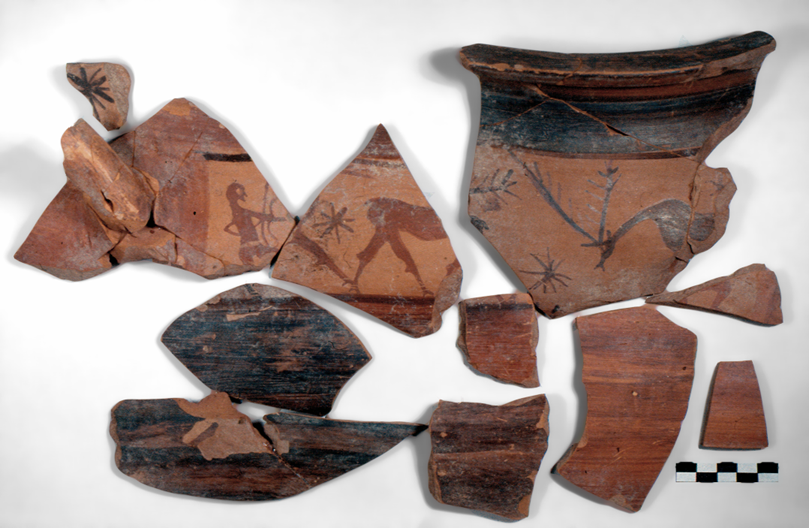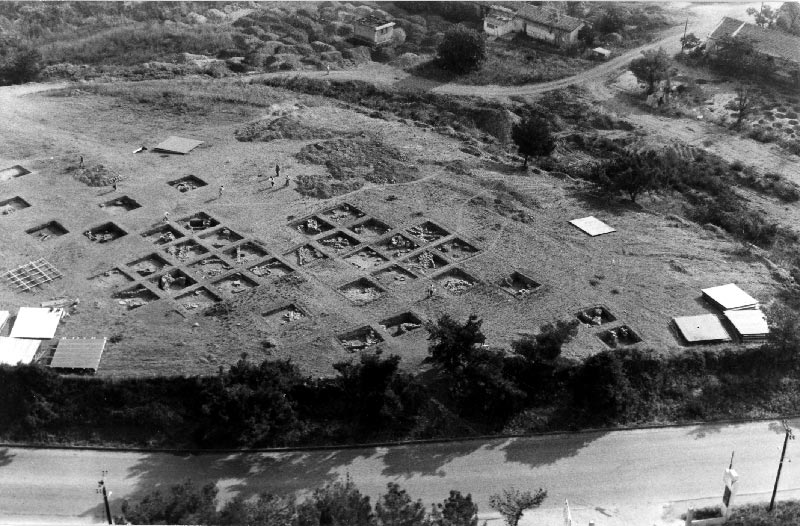The daily needs of the inhabitants of the ancient settlement at Karabournaki were served primarily by clay vases that were produced either on site or in the broader region of modern northern Greece. The local and regional pottery that has been unearthed to date forms an already vast assemblage, the study of which is highly informative not only on the pottery production of the region, but also on several social and economic practices of the local population. This assemblage includes various ceramic wares, which attest the use of different techniques of manufacture and decoration and are related on one hand, to different chronological phases and on the other hand, to different practical, and perhaps also symbolic, functions.
The shapes of coarse wares are highly standardized and are limited to pithoi, which may display cord-like decoration in applied relief, shallow mortars and single- or two-handled chytrai (figs. 1-3). The outside of chytrai is rarely burnished; sometimes there are impressed patterns on their handle(s) or incised ones on their rim and/or body. Although some of these vases belong to the so-called “Thracian pottery”, it should be stressed first, that not all cooking pots at Karabournaki fall under this category and second, that the latter is further represented at the settlement by other shapes, such as mugs and jugs.

Fine wares include both handmade and partly or fully wheelmade vases. The most common handmade wares of the early Iron Age have been fired grey or brown and are usually burnished, but may also bear simple incised or impressed patterns (fig. 4). The most popular shapes are the jug with cut-away neck and cylindrical or twisted handle, and the bowl with horizontal triangular handles or, less frequently, with one or two, knobbed or not, vertical handles. Handmade wares do not show any painted patterns, with the exception of a group of matt-painted one-handled spouted bowls, which are decorated with concentric semicircles (fig. 5). Linear and curvilinear geometric patterns appear also on “silver slip wares”; but the vast majority of these are, at least in part, wheelmade (fig. 6). “Silver slip wares” at Karabournaki include pithoid amphoras, lebetes, jugs and lekanai that are decorated with purple patterns on golden- or red-colored slip; however, there are also golden-slipped pots without any other decoration.

The combination of hand-built with wheel-thrown parts attested at the large-sized shapes of “silver slip wares” is further noted at a series of jugs with cut-away or round mouth, globular body and a plain strap or double or triple handle (fig. 7). These jugs, whose height often exceeds 25 cm, are usually decorated with broad horizontal plain or, more rarely, wavy bands, which are rendered in dull, unevenly applied, glaze; alternatively, they may be fully glazed, with or without superimposed bands. On account of the presence of misshaped examples, these pots must have been manufactured at Karabournaki. Their production must have begun already in the late Geometric period and continued down to the following years. Closely connected to these is a group of smaller-sized fully wheelmade oinochoai and olpai, which are also either banded or fully glazed (fig. 8). These jugs are predominant at the settlement of the early Archaic period and were produced along with skyphoi, spouted bowls, lebetes and lekanai (fig. 9). The potters who manufactured such wares must have also developed, probably within the 7th c. BC, the so-called “eggshell pottery”. The discovery of the waste of a pottery workshop at Karabournaki attests the production of this category on site. The most common shape with eggshell-thin walls is a semispherical bowl with one strap or two cylindrical horizontal handles and a flat base, which occurs at various sizes (rim dm between ca. 10-30 cm) (fig. 10).

If the smaller ones functioned as drinking cups, the larger ones must have been used for the preparation and serving of solid and semi-liquid foodstuffs. The same category includes several olpai (fig. 11), whose height is usually less than 15 cm; less popular were the mug, the oinochoe and the short-handled ladle.

Among the regional wheelmade pottery found at Karabournaki, there is also a limited number of early Iron Age grey wares, mostly mugs (fig. 12). Nonetheless, from the advanced 6th c. BC there is a new category of wheel-thrown grey vases, which show burnishing in horizontal or vertical bands (fig. 13). This type of decoration appears on grey kantharoi, lebetes, column kraters, jugs, hydriai and exaleiptra. Vertical burnishing is also found at a distinctive group of wheelmade jugs with cut-away neck and globular body, whose neck and handle are covered in orange or brown glaze (fig. 14). These jugs, also known in literature as “gourd-shaped”, date from the second half of the 6th c. BC; but they reproduce the form and partly also the decoration of earlier handmade burnished jugs, the production of which begins in the early Iron Age.

Apart from the aforementioned ceramic wares, the settlement at Karabournaki has also yielded a smaller assemblage of locally or regionally produced pots that draw upon southern and eastern Greek models. Interestingly, while sometimes such models are faithfully reproduced, in most cases they are combined with each other or with elements of local inspiration, in original categories of hybrid character. Over the course of the early Iron Age, “silver slip wares” co-exist with close imitations mainly of Euboean shapes with geometric patterns (fig. 15). On the other hand, during the Archaic period external influences originate from eastern Greece and, from the 6th c. BC, also from Corinth. The so-called “Chalkidic wares” (kotylai, oinochoai, hydriai, kraters, lekanai and sipyai), which are decorated with plain or wavy bands, sometimes combined with floral patterns, are strongly dependant on eastern Greek models (fig. 16). The corinthianizing production includes a group of oinochoai, kotylai and exaleiptra, which follow closely Corinthian models, both in terms of shape and decoration (fig. 17). However, it further includes the group of the “bird kotylai” (fig. 18), which is known only from sites in central Macedonia, as well as a series of exaleiptra, which differ considerably from their Corinthian counterparts (fig. 19). Apart from the aforementioned grey burnished examples, there are also semi- or fully-glazed exaleiptra that, just like the grey ones, display a wide variety of forms.

Locally or regionally produced vases with figured decoration are very rare at Karabournaki. With the exception of the animal friezes that appear on some corinthianizing vases, the only other known figured scenes, which depict a deer hunt, decorate an Archaic column krater (fig. 20). Equally unique is the plastic bird attached to the handle of an Archaic jug made by a local potter (fig. 21).

Vivi Saripanidi
